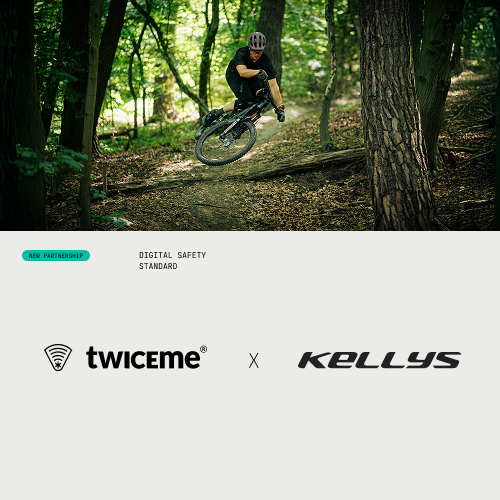US Cyclists Willing to Pay for Twiceme's HTH-Technology in Helmets
Survey by Twiceme reveals 90% of US bike riders are willing to share safety info with rescuers in emergencies. 53% would pay an extra $15 for this technology. Safety tech is the top priority for 28% when buying helmets. Future research to explore age and income factors.

Twiceme, a Swedish safety technology company, recently conducted a survey to gauge the willingness of US bike riders to pay for their innovative safety technology. The survey asked three questions: - "Would you feel safer if personal safety information was shared with rescuers in an emergency?" - "Would you be willing to pay USD 15 extra for equipment that can do this?" - “What’s the most important criterion when buying a new helmet?” The results of the survey were quite interesting.
90% of people want to share their safety information with rescuers
The survey was focused on US bike riders and covered the entire income span. The goal was to understand if people would pay for Twiceme's safety technology, even if it cost a little extra. The survey results indicated that most respondents, approximately 90%, believed they would feel safer if their personal safety information was shared with rescuers in an emergency. This is a significant number and shows that people understand the value of safety technology that can provide immediate help in case of an accident.
A majority want to pay for equipment that speaks for them
When asked if they would be willing to pay an additional USD 15 for the safety technology, 53% of the respondents said yes. This shows that there is a willingness to pay for added safety measures. It is important to note that no mention of Twiceme's brand or the added benefits of why rescuers need this information was provided in the survey. Rescuers say that Twiceme’s product can save lives because the more prepared they are when arriving at the accident, the higher the chance they can act swiftly. As this knowledge spreads, the hypothesis is that more would like to share their information, knowing why it’s valuable to do. Additionally, the survey didn't mention the other features Twiceme provides or the ones they plan to build in the future.
In 2023 and onward, Twiceme aims to build the most valuable network of helpers and arm them with the necessary tools to help in rescue missions. To aid in that mission features providing value both in an emergency and before are being developed. To ensure that Twiceme as a product improves over time, thus bringing more value to the community and brands. Our research shows that safety features is the #1 purchasing criterion for 28% of the sample. The second most important after “fit and comfort.”
Further research will be done, but results look promising
Furthermore, the survey didn't factor in the age of the respondents, which could have affected the results in a negative way. It is known that the younger generation, specifically digital natives, are more safety-aware and tend to prioritize safety when making purchasing decisions. They are also more open to sharing personal information online and with others, which could affect their willingness to pay for safety technology. Further research will be done in this area, but the hypothesis is that results would be more assertive in a younger audience.
Another aspect that the survey didn't consider was the difference in income levels. It is possible that people who have higher incomes would be more willing to pay for premium safety products such as Twiceme's. They might also have a higher percentage of people who are willing to pay the extra USD 15 for added safety technology, since higher income groups might be more safety-conscious and willing to invest in their safety and well-being.
Conclusion - safety technologies are important selling factors for brands
In conclusion, the survey conducted by Twiceme indicates a high demand for safety technologies that can provide immediate help in the event of an accident. The results show that people recognize the value of technology that can provide added safety measures. However, it is essential to note that the survey only covered US bike riders and did not factor in age or income levels. The younger generation, specifically digital natives, might be more open to safety technology and willing to share personal information online. Higher-income people might also be more willing to invest in their safety and well-being.
As Twiceme continues to evolve and provide more features, it will be interesting to see how the market responds and what role Twiceme plays in shaping the future of safety technology. Already, most people would pay USD 15 extra for equipment that provides Twiceme’s Help-the-Helpers technology. As the product improves and Twiceme’s brand value increases, so should the Willingness to Pay. The features are already being developed after verification from the market, rescuers, and brands on what’s the most important. And this will come without adding any license fees or additional costs after the purchase.
Brands that engage with the proper marketing, education, and spread can tap into this market. And provide people with the necessary safety technologies to increase the chances that rescuers save lives and turn bystanders into helpers.
Discover More Exciting Content.
Explore more related articles

Twiceme and KELLYS Bicycles Partner to Bring Digital Safety Technology to Cycling Helmets

Twiceme Introduces Immobility Alert - Designed to Assist When You Can't Call for Help
.jpg)
NÜDL Helmets Partners with Twiceme to Enhance Kids Rider Safety

O'NEAL TRANSITION Helmet with Twiceme HTH-Technology: The Best Buy in German Mountainbike Magazine

POC Release Limited Edition EF Education-EasyPost Helmet
